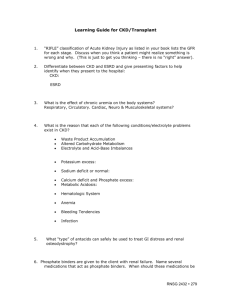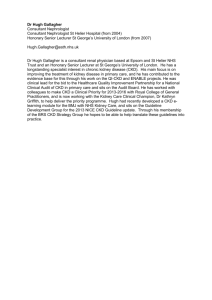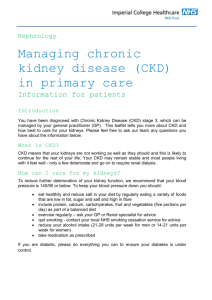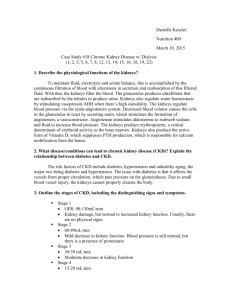CKD Case Study: Dialysis & Nutrition
advertisement
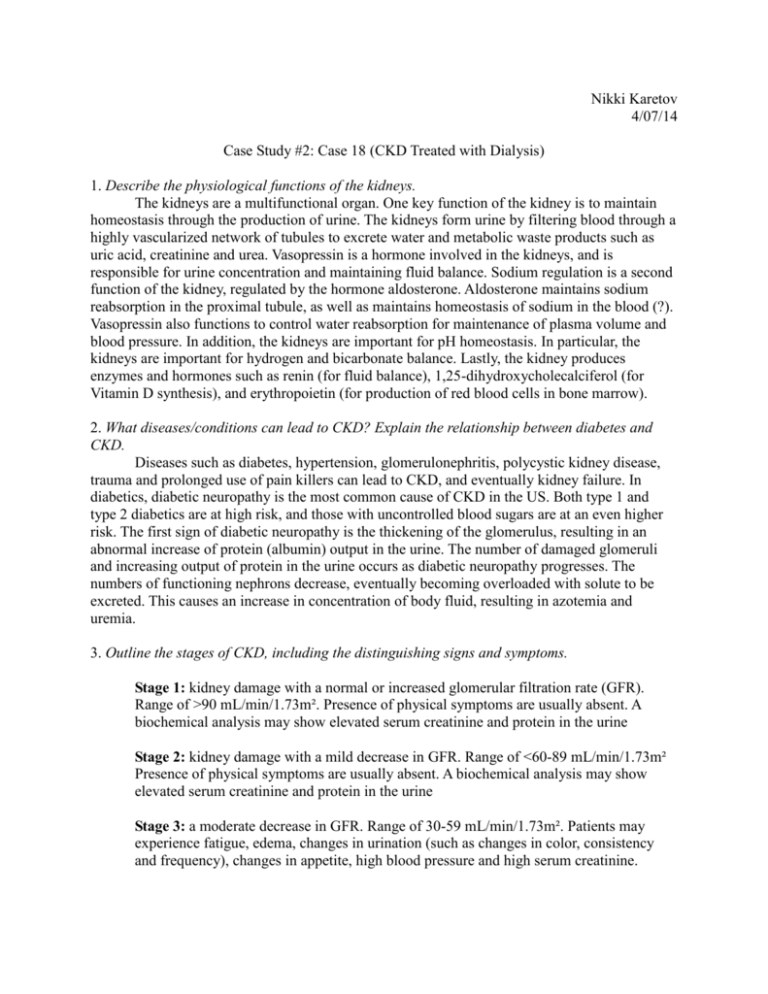
Nikki Karetov 4/07/14 Case Study #2: Case 18 (CKD Treated with Dialysis) 1. Describe the physiological functions of the kidneys. The kidneys are a multifunctional organ. One key function of the kidney is to maintain homeostasis through the production of urine. The kidneys form urine by filtering blood through a highly vascularized network of tubules to excrete water and metabolic waste products such as uric acid, creatinine and urea. Vasopressin is a hormone involved in the kidneys, and is responsible for urine concentration and maintaining fluid balance. Sodium regulation is a second function of the kidney, regulated by the hormone aldosterone. Aldosterone maintains sodium reabsorption in the proximal tubule, as well as maintains homeostasis of sodium in the blood (?). Vasopressin also functions to control water reabsorption for maintenance of plasma volume and blood pressure. In addition, the kidneys are important for pH homeostasis. In particular, the kidneys are important for hydrogen and bicarbonate balance. Lastly, the kidney produces enzymes and hormones such as renin (for fluid balance), 1,25-dihydroxycholecalciferol (for Vitamin D synthesis), and erythropoietin (for production of red blood cells in bone marrow). 2. What diseases/conditions can lead to CKD? Explain the relationship between diabetes and CKD. Diseases such as diabetes, hypertension, glomerulonephritis, polycystic kidney disease, trauma and prolonged use of pain killers can lead to CKD, and eventually kidney failure. In diabetics, diabetic neuropathy is the most common cause of CKD in the US. Both type 1 and type 2 diabetics are at high risk, and those with uncontrolled blood sugars are at an even higher risk. The first sign of diabetic neuropathy is the thickening of the glomerulus, resulting in an abnormal increase of protein (albumin) output in the urine. The number of damaged glomeruli and increasing output of protein in the urine occurs as diabetic neuropathy progresses. The numbers of functioning nephrons decrease, eventually becoming overloaded with solute to be excreted. This causes an increase in concentration of body fluid, resulting in azotemia and uremia. 3. Outline the stages of CKD, including the distinguishing signs and symptoms. Stage 1: kidney damage with a normal or increased glomerular filtration rate (GFR). Range of >90 mL/min/1.73m². Presence of physical symptoms are usually absent. A biochemical analysis may show elevated serum creatinine and protein in the urine Stage 2: kidney damage with a mild decrease in GFR. Range of <60-89 mL/min/1.73m² Presence of physical symptoms are usually absent. A biochemical analysis may show elevated serum creatinine and protein in the urine Stage 3: a moderate decrease in GFR. Range of 30-59 mL/min/1.73m². Patients may experience fatigue, edema, changes in urination (such as changes in color, consistency and frequency), changes in appetite, high blood pressure and high serum creatinine. Stage 4: a severe decrease in GFR. Range of 15-29 mL/min/1.73m². Patient may experience fatigue, edema, kidney pain, sleeping problems, nausea/vomiting, taste changes, uremic breath, loss of appetite, difficulty concentrating and nerve problems. Stage 5: GFR = < 15 mL/min/1.73m². Kidney function is inadequate to sustain life and requires initiation of renal replacement theory. Patient may experience a loss of appetite, nausea/vomiting, headaches, fatigue, inability to concentrate, itching, producing little to no urine, swelling, muscle cramps, tingling in the hands or feet, and changes in skin color 4. From your reading of Mrs. Joaquin's history and physical, what signs and symptoms did she have that correlate with her CKD? Mrs. Joaquin's BMI is 33, which indicates that she is obese. Her BMI was calculated using her current body weight with edema. Her signs and symptoms include swelling, a declining GFR, an increased creatinine and urea concentration, elevated serum phosphate, and normochromic, microcytic anemia. She also complains of a loss of appetite, nausea/vomiting, a 4 pound weight gain in the past 2 weeks, edema in the extremities, face and eyes, malaise, pruritis, and muscle cramps. In addition, she states she has stopped taking her hypoglycemic medications to control her diabetes, as well as her antihypertensive medications which both may be contributing to her disease state. 5. What are the treatment options for Stage 5 CKD? Explain the difference between hemodialysis and peritoneal dialysis. Harmful waste buildup in the blood, a rise of blood pressure and fluid retention are associated with Stage 5 CKD. More extensive treatments such as hemodialysis, peritoneal dialysis or kidney transplantation is required to sustain the life of the individual. Hemodialysis is the more common treatment, but type of treatment depends on comorbidity factors such as cardiovascular disease, age, family support and proximity to a dialysis center. Type of treatment depends on the needs and desires of the patient as well. Hemodialysis involves access to the circulatory system through an external route that can be regularly accessed. A permanent access site, called an arteriovenous fistula (AVF) is the preferred method. It is created surgically by joining the radial artery and cephalic vein together in the forearm, subcutaneously. It may take between 4 to 6 weeks for the AVF to become fully functional. A arteriovenous graft (AVG) may be required if the blood vessels in the forearm are inadequate. The blood that is extracted from the body using needle sticks is run through a dialyzer, where dialysate acts on the blood to remove waste products and excess electrolytes via diffusion, ultrafiltration and osmosis. Once the blood has passed through this artificial kidney, the blood can return back to the patient. Hemodialysis must take place at a dialysis center, typically 3 times per week for 4 hours at a time. Peritoneal dialysis involved a catheter placed directly into the peritoneal cavity. A dialysate solution can enter the peritoneal cavity though the catheter to capture solutes from plasma circulating in the peritoneal walls. The dialysate solution with the addition of solutes can then be removed through the catheter. In continuous ambulatory peritoneal dialysis (CAPD), no machine is required and the patient can sleep with dialysate in the peritoneum overnight. Every 4-6 hours the dialysate solution is changed out. This is different than continuous cycling (CCPD), which uses a machine to change out the solution 3-5 times at night. In the day, the solution only has to be replaced one or two times. 6. Explain the reasons for the following components of Mrs. Joaquin's MNT: Nutrition Therapy Rationale 35 kcal/kg Calories will need to be adequate to prevent catabolism and ensure nutritional status. It is important to maintain calories through protein, carbohydrates and fat to prevent muscle breakdown. 1.2 g protein/kg Protein needs will be increased to make up for daily free amino acid and albumin losses, altered albumin turnover, metabolic acidosis, and to reduce inflammation and infection 2gK Mrs. Joaquin's charts indicate that her potassium is elevated, which puts her at risk for hyperkalemia. Potassium restriction is required to prevent hyperkalemia development. 1 g phosphorus Her charts also reflect that she has elevated phosphorus levels. It is important to control her intake of phosphorus to prevent calcium loss from the bones. 2 g Na It is important to restrict her sodium intake to control her blood pressure and to regulate electrolyte status in her blood. 100 mL fluid + urine output Adequate fluid intake will maintain blood volume and pressure, as well as prevent weight gain from edema, hypertension and congestive heart failure. 7. Calculate and interpret Mrs. Joaquin's BMI. How does edema affect your interpretation? BMI = 77.3 kg / 1.524 m² = 33 Mrs. Joaquin is obese. However, edema is associated with kidney disease as previously mentioned. The extra fluid weight could be causing her to weigh more and cause an increase in BMI. 8. What is edema-free weight? Calculate Mrs. Joaquin's edema-free weight. Edema-free weight is an adjusted calculation to measure a patient's body weight without fluid accumulation from edema. Edema free weight = [edema free wt – ideal body wt (Hawmi equation)] x 0.25 + ideal body wt EFW = current wt (170 lbs) – recent wt gain (4 kg = 8.8 lbs) = 162 lbs = 73 kg IBW (Hamwi) = 100lbs = 45.4 kg EFW = (73 kg – 45.4 kg) x 0.25 + 45.4 kg = 52.3 kg = 115.1 lbs 10. Calculate what Mrs. Joaquin's energy needs will be once she begins hemodialysis. Once she begins hemodialysis, she will need 30-35 kcals/kg. Therefore, she will need around 1575 – 1830.5 kcals using her adjusted edema-free body weight. Since she is a younger patient, she will need to have a daily intake of calories more toward the upper end of the given range. 11. What will Mrs. Joaquin's protein requirements be when she begins hemodialysis? What standard guidelines have you used to make these recommendations? Her protein needs will increase at 1.2 – 1.4 g/kg per day. Therefore, she will need 62.8 – 73.2 g protein using her adjusted edema-free body weight. The standard guidelines used are from the National Kidney Foundation K/DOQI clinical practice guidelines. 12. What are the considerations for differences in protein requirements among predialysis, hemodialysis and peritoneal dialysis patients? Predialysis patients will need 0.6-0.8 g/kg of protein per day. These patients are put on protein restriction to delay progression of the disease. Once the patient begins hemodialysis, protein needs will increase to 1.2 -1.4 g/kg per day to replenish the losses of both free amino acids and albumin and to prevent inflammation and infection. Protein needs for peritoneal patients are slightly higher than for HD due to the possibility of inflammation of the peritoneum, which has the ability to result in a protein deficit of 50% to 100% in even the mildest of cases. 13. Mrs. Joaquin has a PO4 restriction. Why? What foods have the highest level of phosphorus? The patient has a PO4 restriction because her serum PO4 levels are high. In CKD, phosphate retention occurs, which can cause hyperparathyroidism and an increase in calcium reabsorption from the bones. A PO4 restriction is important for Mrs. Joaquin to manage her serum phosphate levels. Some foods that have high levels of phosphorus include: Fruits: apricots, avocados, bananas, cantaloupe Vegetables: acorn squash, artichokes, bamboo shoots, baked beans, butternut squash Dairy: all types of milk, cheese, custard, cottage cheese Protein: carp, beef liver, fish roe, oysters, crayfish, chicken livers Other: bran/bran products, chocolate, granola, molasses, nuts and seeds 14. What foods are considered to be fluids? What recommendations can you make for Mrs. Joaquin? If a patient must follow a fluid restriction, what can be done to help reduce his/her thirst? Fluid requirements are highly individualized between CKD patients. Mrs. Joaquin's requirements will be based on her urine output, type of dialysis, as well as the status of her blood pressure, interdialytic weight gains, presence of edema, and congestive heart failure. Foods that are fluids include anything that is fluid at room temperature. This includes pudding, popsicles, ice cream, gravy, sauces, sherbet, jello, ice, some fruit and all drinks. To reduce thirst, some recommendations are: Limit high-salt foods to minimize thirst Take medications with mealtime liquids, applesauce or pureed fruits Drink from smaller cups Drink only when thirsty. Drink very cold beverages that are unsweetened Use sour candy or gum to moisten mouth Add lemon juice to water or ice Swish mouth around with water or low-alcohol mouthwash Suck on ice cubes Freeze fruits such as grapes, blueberries, pineapple I would also advise her to weigh herself daily to make sure she isn't gaining any more fluid weight than her prescribed number of pounds each day, and to maintain good mouth hygiene by brushing her teeth often. 16. Evaluate Mrs. Joaquin's chemistry report. What labs support the diagnosis of Stage 5 CKD? The patients chemistry report reflects several factors that support the diagnosis of Stage 5 CKD. This includes elevated potassium, blood urea nitrogen, creatinine, serum phosphate levels and hemoglobin A1C. Her report also shows that her CO2 and calcium levels are low. In addition, her urinalysis shows altered kidney function with a high pH, presence of a high amount of protein and high white blood cells. 20. Choose 2 high-priority nutritional problems are write a complete PES statement for each. PES #1: Overweight/obesity related to fluid accumulation from progression of Stage 5 CKD as evidenced by an elevated BMI, a 4 kg weight gain in the past 2 weeks, and edema of the extremities, face and eyes. PES #2: Altered nutrition-related lab values related to Stage 5 CKD as evidenced by elevated serum potassium, high serum phosphate, high creatinine and abnormal urinalysis report. 21. For each PES statement, establish an ideal goal (based on signs and symptoms) and appropriate intervention (based on the etiology). Goal for PES #1: To prevent weight gain from fluids, Mrs. Joaquin should both monitor her fluid and sodium intake. A low-sodium diet may be appropriate for the patient. This includes avoiding processed foods, processed lunch meats, certain types of dairy, canned vegetables or beans, and high-salt condiments. She should also control her fluid intake by practicing tips to reduce thirst (previously mentioned), to drink from smaller cups, maintain good oral hygiene and to drink only when thirsty. Nutrition education on both low-sodium diets and controlling fluid intake is recommended for Mrs. Joaquin. Goal for PES #2: To help manage her altered lab values, Mrs. Joaquin should properly manage her diet. The goal is to get her altered lab values as close to a normal range as possible. In particular, she should have a specific intake of protein per day to maintain neutral or positive nitrogen balance and to prevent catabolism. She should also monitor her potassium intake to prevent hyperkalemia, monitor phosphorus to prevent hyperparathyroidism and monitor sodium intake to prevent water retention and maintain blood pressure. Mrs. Joaquin should speak to an RD to get nutrition education on how to properly manage her diet with Stage 5 CKD. 22. Why is it recommended for patients to have at least 50% of their protein from sources that have high biological value? It is recommended for patients to have at least 50% of their protein come from high biological value to maintain positive or neutral nitrogen balance. It will also maintain or improve visceral protein stores for most patients on hemodialysis. High biological sources of protein are complete proteins such as eggs, meat, fish, poultry, cheese milk, and some soy products. 24. Using Mrs. Joaquin's typical intake and the prescribed diet, write a sample menu. Make sure you can justify your changes and that it is consistent with her nutrition prescription. Diet PTA Sample Menu Breakfast: Cold cereal (3/4c unsweetened) Avoid whole grain cereal (high in K, P). Choose a cereal like corn flakes, rice cereal or other cereals low in sugar (minimize thirst) Bread (2 slices) or fried potatoes (1 medium potato) 1 slice of white bread (low in K, P) and add a fat to slow absorption and prevent a spike in blood glucose levels. Choose a fat low in saturated fat and cholesterol. Prepare fried potatoes with less salt. Substitute salt for a nosalt seasoning mix. Potatoes can also be oven roasted and leached to minimize potassium content 1 fried egg (occasionally) Scrambled egg whites (lower in P, K and cholesterol) Lunch: Bologna sandwich (2 slices white bread, 2 slices bologna, mustard) Substitute bologna for other lunch meat low in salt. Choose fresh and un-breaded meats, such as chicken. Make sure to look for chicken without any added phosphates. Prepare chicken using herbs and spices for flavor. Potato chips Substitute processed foods for other healthy snacks, such as popcorn without added salt to reduce sodium content. Choose reduced sodium snacks if possible, and try to consume a smaller portion. 1 can Coke Choose a low potassium fruit juice or diet soda (lower in P, no sugar). Ginger ale and Sprite are good options too (do not contain P) Dinner: Chopped meat (3 oz beef) Choose a lean meat like chicken or fish (low in saturated fat). Prepare using a dry heat method and used herbs and spices instead of salt. Fried potatoes (1 ½ medium) Roasted potatoes (lower in fat) that have been leached to reduce potassium content. HS Snack: Crackers (6 saltines) and peanut butter (2tbsp) Substitute salted crackers for no salt added version if possible. Try eating berries, pineapple or apple slices (low in P). Use a low fat cream cheese or a jam/fruit spread (low in P, K)


